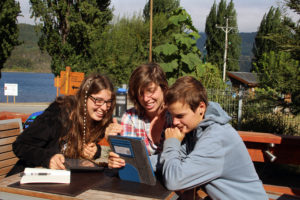Scaffolding and Support for English Language Learners
In our increasingly globalized world, bilingualism and ‘biliteracy’ have become highly valued and sought after skills. Students in classrooms across the United States often grow up speaking a language other than English at home or immigrate from countries with other primary languages. These students inherently contribute to their schools by bringing funds of knowledge, culture, and linguistic prowess. Some, though not all, of these students are considered English Language Learners (ELLs) at some point in their educational journey. With the increase in varying levels and types of language learners, we at Alzar School are continually examining the best techniques and practices we can implement to help our students learn a nonnative language and be successful with core classes taught primarily in English.
Each semester, Alzar School hosts one or more students for whom English is not their first language. These students come to Alzar School with varying levels of language proficiency, both in informal environments and academic contexts. So, how do we ensure our English Language Learners have the tools and knowledge to succeed at Alzar School?
First, as educators, we must understand the ways in which language is acquired. As language acquisition theorist Stephen Krashen established, this includes several well-established hypotheses to guide language instruction and academic support. In a recent “PD30” (weekly 30-minute professional development for teaching staff) Director of Studies, Laura Bechdel, gave context on Krashen’s “comprehensible input” theory, then dove into an analysis of the BICs vs CALP Iceberg Model. BICs refers to Basic Interpersonal Communication Skills. These skills are mostly conversational and communicative skills that are developed within one or two years of acquiring a language. Examples of these skills are face-to-face conversations or a telephone conversation. CALP refers to Cognitive Academic Language Proficiency. These skills are cognitively demanding skills, requiring more analysis and interpretation of the abstract, and are usually developed in five or more years of learning a language. Our goal in supporting English Language Learners at Alzar School is that we help students gain both BICs and CALP, thus giving them the ability to communicate and relate to our community and culture, and also to demonstrate content knowledge in academic areas through higher-order thinking skills.

In the classroom, out on the trail, and in residential settings, Alzar School teachers adapt their instruction and coaching to help ELL students understand and learn. First, instructors may adopt a “show and tell” pedagogy through non-verbal communications. They demonstrate and model techniques, utilize “think aloud” methods, or show an example of an end product. Secondly, teachers often break down learning by chunking assignments. For example, an essay assignment can be segmented into three parts: an outline, rough draft and final draft. Similarly, teachers will number instructions, saying out loud the steps and simultaneously writing them down. This method also allows teachers to check for understanding by asking, ‘what is the first thing you’ll do, what’s the second…” Woven throughout these techniques, instructors often differentiate lessons for ELL students — offering key vocabulary lists, guided readings, class notes, or assigning alternative end products. Finally, teachers keep instruction real for students. They utilize visuals, graphic organizers, and charts, and provide students time to talk and converse in their first language. Through it all, teachers connect the content at hand to students’ prior knowledge and experiences.
As Stephen Krashen pointed out, learning a language, at its basic form, is understanding messages. Alzar School is working hard to help our ELL students understand all types of information through various techniques and modified instruction to ensure they are engaged and challenged in the classroom as well as ready and prepared for adventure on campus and in the outdoors.

